c3controls line of IEC Contactors are ideal for motor, actuator, solenoid, and other power switching applications.
Introduction to Contactors
A contactor is an electrical device which is used for switching an electrical circuit on or off. It is considered to be a special type of relay. However, the basic difference between the relay and contactor is that the contactor is used in applications with higher current carrying capacity, whereas the relay is used for lower current applications. Contactors can be field mounted easily and are compact in size. Generally, these electrical devices feature multiple contacts. These contacts are in most cases normally open and provide operating power to the load when the contactor coil is energized. Contactors are most commonly used for controlling electric motors.
There are various types of contactors, and each type has its own set of features, capabilities, and applications. Contactors can break current over a wide range of currents, from a few amperes to thousands of amperes, and voltages from 24 VDC to thousands of volts. In addition, these electrical devices come in varying sizes, from hand-held dimensions to sizes measuring a meter or yard on one side (approximately).
The most common application area of the contactor is high-current load. Contactors are known for their capability to handle currents of over 5000 amperes and high power over 100 kW.
Load capacity: Contactors vs Relays
Relays: Generally used with currents of 5A-15A, the rating of the relay is typically 10A or less.
Contactors: They are designed and built for use higher-power switching applications. They are designed for carrying currents from a few amperes to thousands of amperes, with an ability to manage high power over 100 kW.
This makes contactors more appropriate for stronger applications that require the handling of high-current loads, while relays are better suited for lower current tasks.
Contactor Components
The following three are crucial components of the contactor:
- Coil or Electromagnet: This is the most crucial component of a contactor. The driving force that is required to close the contacts is provided by the coil or electromagnet of the contactor. The coil or electromagnet and contacts are protected by an enclosure.
- Enclosure: Just like the enclosures used in any other application, contactors also feature an enclosure, which provides insulation and protection from personnel touching the contacts. The protective enclosure is made from different materials, such as polycarbonate, polyester, Nylon 6, Bakelite, thermosetting plastics, and others. Generally, the open-frame contactor features an additional enclosure, which protects the device from bad weather, hazards of explosion, dust, and oil.
- Contacts: This is yet another important component of this electrical device. The current carrying task of the contactor is done by the contacts. There are different types of contacts in a contactor namely, contact springs, auxiliary contacts, and power contacts. Each type of contact has an individual role to play.
How the Contactor Operates
Operating Principle of a Contactor:The current passing through the contactor excites the electromagnet. The excited electromagnet produces a magnetic field, causing the contactor core to move the armature. A normally closed (NC) contact completes the circuit between the fixed contacts and the moving contacts. This permits the current to pass through these contacts to the load. When current is removed, the coil is de-energized and opens the circuit. The contacts of the contactors are known for their rapid open and close action.
Different Types of Contactor Devices
Knife Blade Switch
The knife blade switch was used earlier in the late 1800’s. It was probably the first ever contactor that was used to control (start or stop) electric motors. The switch consisted of a metal strip, which would drop onto a contact. This switch had a lever for pulling the switch down or pushing it up. Back then, one had to level the knife blade switch into the closed position by standing next to it.
However, there was a problem with this method of switching. This method caused the contacts to wear out quickly, since it was difficult to manually open and close the switch fast enough to avoid arcing. As a result of this, the soft copper switches underwent corrosion, which further made them vulnerable to moisture and dirt. Over the years, the size of the motors increased which further created the need for larger currents to operate them. This created potential physical danger to operate such high current carrying switches, thus leading to a serious safety concern. In spite of doing several mechanical improvements, the knife blade switch couldn’t be fully developed due to the pertaining problems and risks of dangerous operation and short life of the contacts.
Manual Controller
Since the knife blade switch became potentially dangerous to use, engineers came up with another contactor device, which offered a number of features that were missing in the knife blade switch. This device was referred to as a manual controller. These features included:
- Safe to operate
- Non-exposed unit, which is properly encased
- Physically smaller size
- Single break contacts replaced with double break contacts
As their name implies, double break contacts can open the circuit in two places at the same time. Thus, even in smaller space, it allows you to work with more current. Double break contacts divide the connection in such a way that it forms two sets of contacts.
The switch or button of the manual controller is not operated remotely and is attached to the controller physically.
The power circuit is engaged once the manual controller is activated by an operator. Once activated, it carries the electricity to the load. Soon, manual contactors replaced knife blade switches completely, and even today different variations of these types of contactors are being used.
Magnetic Contactor
The magnetic contactor does not require human intervention and operates electromechanically. This is one of the most advanced designs of a contactor, which can be operated remotely. Thus, it helps eliminate the risks involved in operating it manually and putting operating personnel in potential danger. Only a small amount of control current is required by the magnetic contactor to open or close the circuit. This is the most common type of contactor used in industrial control applications.
What is the Most Common Reason for Contactor Failure?
There are many reasons that can result in the failure of electrical contactors, but the most common one is welding contacts or sticking. It is the condition of contacts within the equipment fusing together or sticking at a point.
One of the main reasons attributed to this is high inrush currents. The currents cause overheating and welding of the contact surfaces. Other reasons include unstable control voltages and short transition times between high peak currents, which result in extra stress on contacts, therefore leading to failure. With time, normal wear and tear are capable of wearing off the surface alloys of the contact terminals, therefore exposing the underlying copper, which is more likely to weld.
Infrequently, contactors can also fail through coil burn, the occurrence of the coil receiving either too much or too little voltage. Environmental factors such as dirt, dust, or moisture can also enter the coil's air gap, further aggravating the situation.
What Should You Consider When Selecting a Contractor?
It's a very important process to keep in mind when selecting a contactor in order to obtain maximum performance and lifespan.
First off, you'll need to evaluate your load requirements. It's necessary for you to know the type and amount of current that your contactor will be required to handle. This includes both voltage and current specifications for your particular application.
Secondly, power ratings. Check the maximum voltage and current that the contactor can safely switch. The ratings have to meet your requirements in preventing overloads and enhancing long life.
Additional factors to consider include:
Coil Voltage: The voltage needed to energize the contactor's coil.
Contact Configuration: Whether you need single-pole, double-pole, or multi-pole configurations.
Durability and Lifespan: Look for high-quality materials and robust construction for long-term use.
Mounting Options: Ensure the contactor can be easily installed in your intended location.
Incorporating these considerations will help you choose a contactor that meets your specific requirements effectively.
Common Safety Features of Contactors
Contactors are equipped with several key safety features to protect both the electrical system and its users. Understanding these features can help ensure that the equipment operates safely and efficiently. Common Safety Features of Contactors:
Spring-Loaded Contacts
These contacts are designed to automatically interrupt the electrical circuit if the contactor loses power. This immediate disconnection helps prevent accidental electrical flow and reduces the risk of electrical hazards.
Overload Protection
Overload protection is crucial for preventing damage from current surges. If the circuit experiences a surge beyond a predefined threshold for a certain duration, the overload protection mechanism will activate, safeguarding connected equipment and preventing potential fires.
Magnetic Arc Suppression
This feature addresses the issue of electric arcs, which can occur when the electrical current jumps gaps between contacts. Magnetic arc suppression forces these arcs to travel a longer path, dissipating their energy and reducing the risk of damage or fire.
These features collectively enhance the safety and reliability of contactors in various electrical applications, ensuring that both the systems and the users remain protected.
The Life Expectancy of a Contactor or Contact Life
The life expectancy of a contactor or its “contact life” is one of the biggest concerns of a user. It is natural that the contacts are being opened and closed more frequently, the life of the contactor will decrease. The opening and closing of the contacts create an electric arc, which generates additional heat. The continued production of these arcs can damage the contact surface.
Furthermore, the electrical arcs cause pitting and burn marks, which eventually blacken the contacts. However, the black deposit or oxide on the contacts make them even more capable of conducting electricity efficiently. Nevertheless, when the contacts get worn out and corroded to a large extent, then it is necessary to replace them.
Thus, the faster the contact closes, the quicker the arc extinguishes. This in turn helps to increase the life of the contact. The latest contactor versions are designed in such a way that they close very quickly and energetically. This causes them to slam against each other and produce a bouncing action as they rebound. This action is known as contact bounce. The contact bounce phenomenon creates a secondary arc. It is not only important to close the contacts quickly, but also to reduce the contact bouncing. This helps reduce wear and secondary arcing.
NEMA vs IEC
There are two standards for contactors: NEMA and IEC.
NEMA (National Electrical Manufacturers Association)
NEMA is the largest trade association of electrical equipment manufacturers in the United States. NEMA encouraged manufacturers to standardize on frame sizes to allow users to confidently specify, purchase, and install electrical components from different manufacturers without a lot of hassle and cross-referencing. NEMA contactors also are designed with safety factors that go beyond design ratings (oversized), up to as much as 25%. NEMA is primarily a North American Standard.
NEMA contactors for low-voltage motors (less than 1,000 volts) are rated according to NEMA size, which gives a maximum continuous current rating and a rating by horsepower for attached induction motors. NEMA standard contactor sizes are designated 00, 0, 1, 2, 3 to 9.
IEC (International Electrotechnical Commission)
IEC is a global standard. IEC contactors are not oversized. They are smaller than NEMA contactors and less expensive. The range of sizes offered by manufacturers is more numerous than the ten NEMA standards. As such, they are more specific to a given application and are specified when the operating conditions are well understood. Whereas, NEMA may be chosen when operating conditions, such as load are not well defined.
IEC contactors are also “finger safe.” Whereas NEMA requires safety covers on contactor terminals. Another key difference is IEC contactors react faster to overloads, NEMA contactors are better at withstanding short circuits.
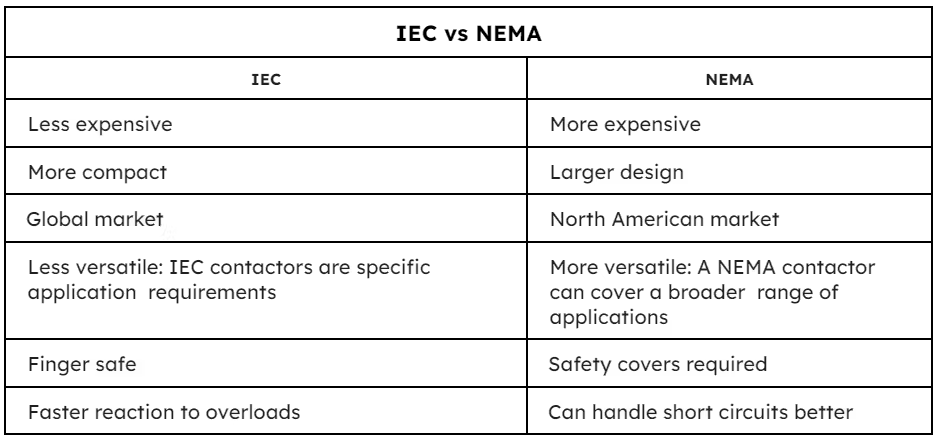
People often mistakenly perceive NEMA contactors as more robust. In reality, this is due to their design being oversized.
The two tables below detail how NEMA and IEC size contactors and starters.
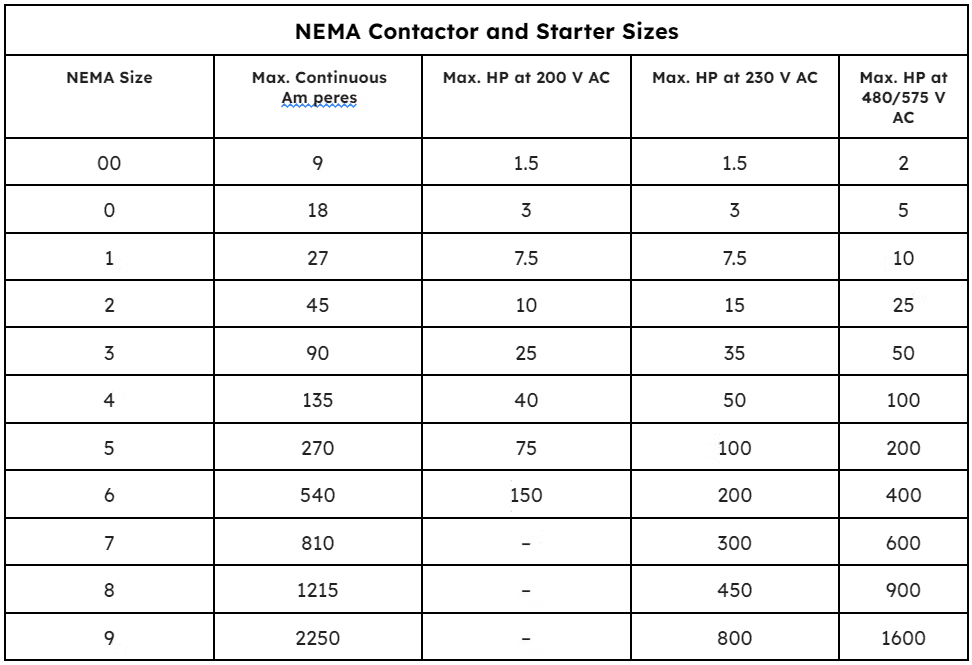
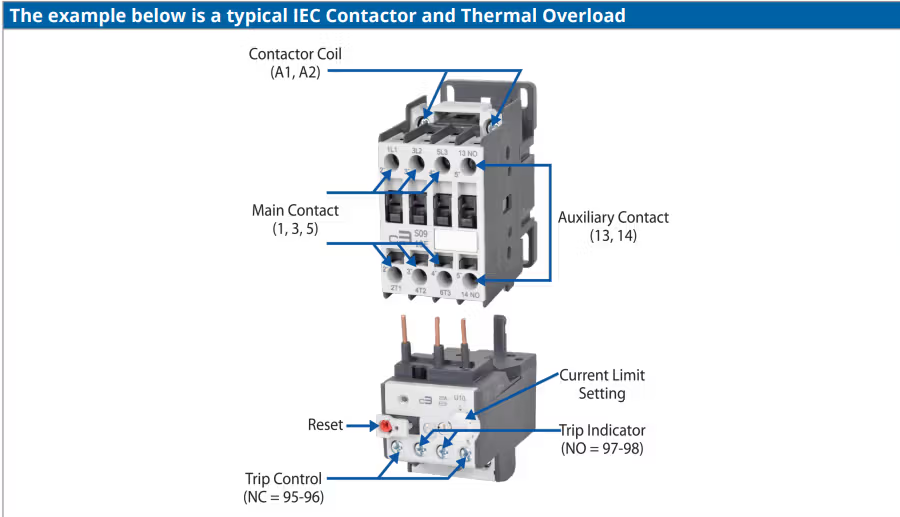
The Role of Electrical Ratings
When working with contactors, it's essential to understand the significance of their electrical ratings. These ratings are categorized as resistive or inductive, each serving different applications based on the module's purpose.
Resistive Ratings
Resistive ratings are associated with applications that involve steady, non-varying loads. These ratings are most commonly used for:
Heating Elements: Systems that require a stable flow of electricity without significant spikes.
Lighting Control: Fixtures where the electrical demand remains constant when the lights are turned on.
In these applications, the contactor manages electricity efficiently and safely because the load remains steady.
Inductive Ratings
Inductive ratings, on the other hand, are designed for applications that experience fluctuations in electrical demand. Common uses include:
Motors: Devices that need surge power to start and then operate at a lower, steady rate.
Transformers: Equipment that experiences variations in current and voltage during operation.
Solenoids: Electromagnetic devices that require large initial current surges.
In these scenarios, the contactor must handle both the initial surge and the subsequent drop in demand without overheating or failing.
Choosing the Right Rating
Understanding whether your application requires resistive or inductive ratings helps ensure optimal performance and longevity of the contactor. For stable loads, opt for resistive-rated contactors. For variable loads, choose inductive-rated ones. This careful selection can prevent equipment malfunctions and extend the life of the contactor.
Understand Switch Ratings and Coil Ratings on a Contactor
Switch ratings and coil ratings on a contactor provide essential information about the device's capabilities and limitations.
Switch Ratings
Switch ratings primarily indicate the maximum voltage and current the contactor can manage. These metrics ensure the contactor can handle the electrical load without failing. For instance:
- Maximum Switching Voltage: This specifies the highest voltage the contactor's contacts can handle safely.
- Maximum Switching Current: This denotes the maximum current the contactor can switch without damage.
These ratings must align with the requirements of the circuit or motor where the contactor will be used to ensure proper functionality and safety.
Coil Ratings
Coil ratings detail the electrical characteristics of the coil within the contactor. Important aspects include:
- Maximum Coil Voltage: The highest voltage that can be applied to the coil.
- Contact Current Rating: The maximum current the contacts can carry.
- Contact Voltage Rating: The highest voltage the contacts can manage.
Manufacturers often provide additional specifications such as:
- Overall Power Rating: The total power the contactor can handle.
- Number of Auxiliary Contacts: Extra contacts available for additional functions.
- Terminal Type: The kind of connections the contactor uses.
- Normal State Configuration: Indicates whether the contacts are normally open (NO) or normally closed (NC).
- Operating Temperature Range: Minimum and maximum temperatures for safe operation.
Given that contactors generate more heat compared to relays, it's critical to consider their heat dissipation properties when selecting a unit. This careful assessment ensures that the selected contactor will operate reliably within its specified ratings, maintaining safety and efficiency in the electrical system.
Applications
Lighting Control
Contactors are often used to provide central control of large lighting installations, such as an office building or retail building. To reduce power consumption in the contactor coils, latching contactors are used, which have two operating coils. One coil, momentarily energized, closes the power circuit contacts, which are then mechanically held closed; the second coil opens the contacts.
Electric Motor Starter
Contactors can be used as a magnetic starter. A magnetic starter is a device designed to provide power to electric motors. It includes a contactor as an essential component, while also providing power-cutoff, under-voltage, and overload protection.
Examples of Motor Control
Single Phase Electric Motor
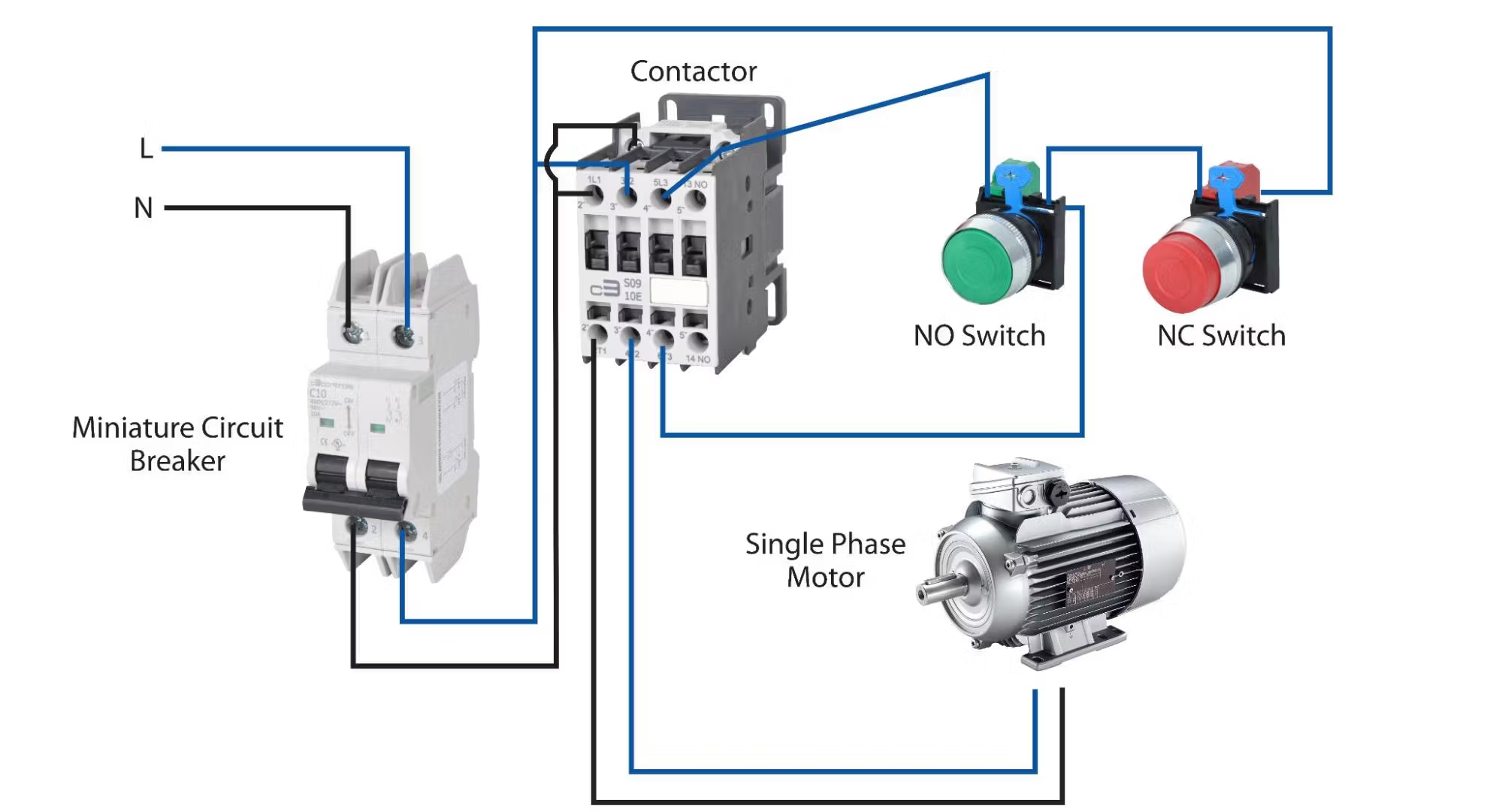
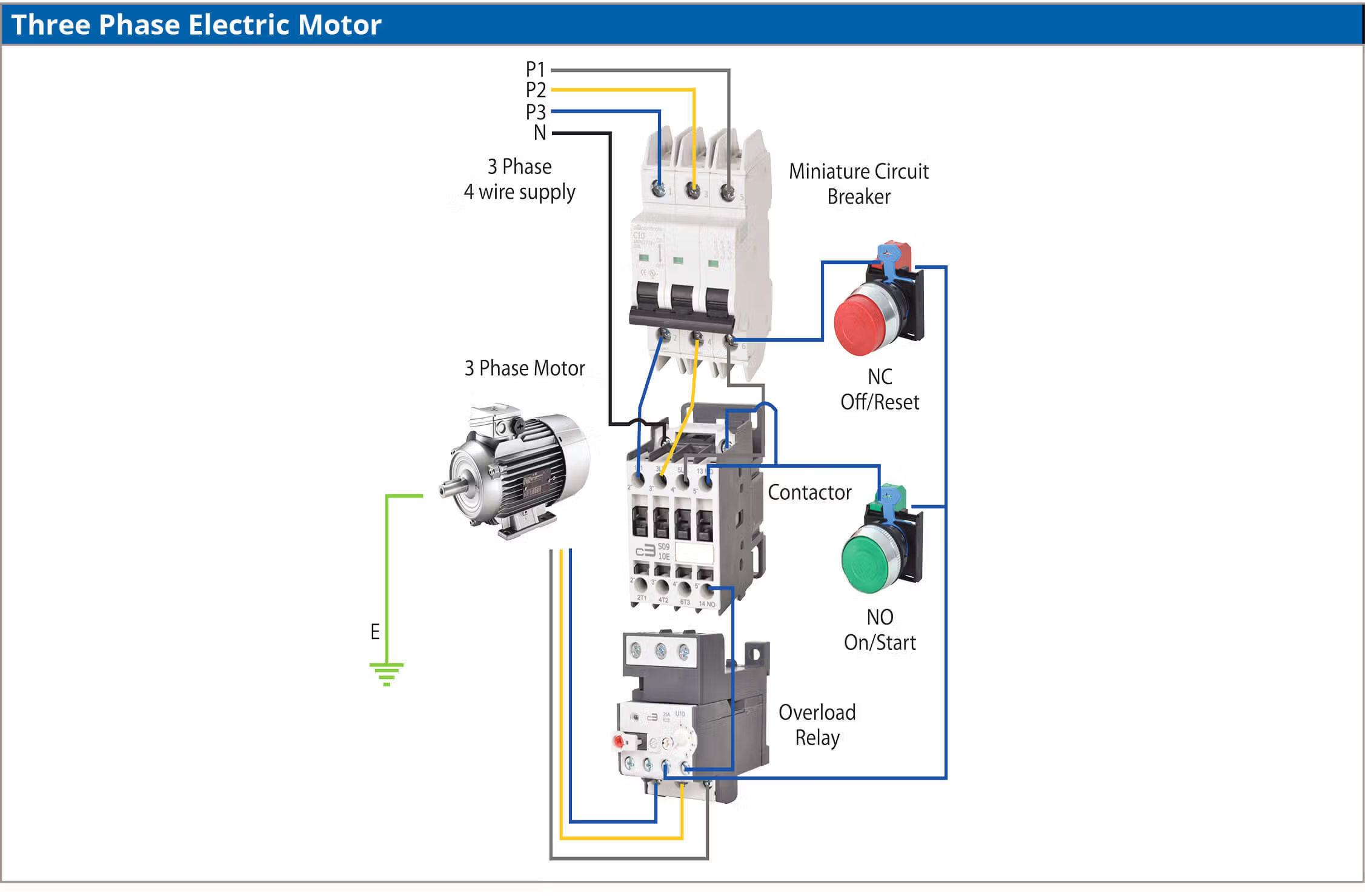
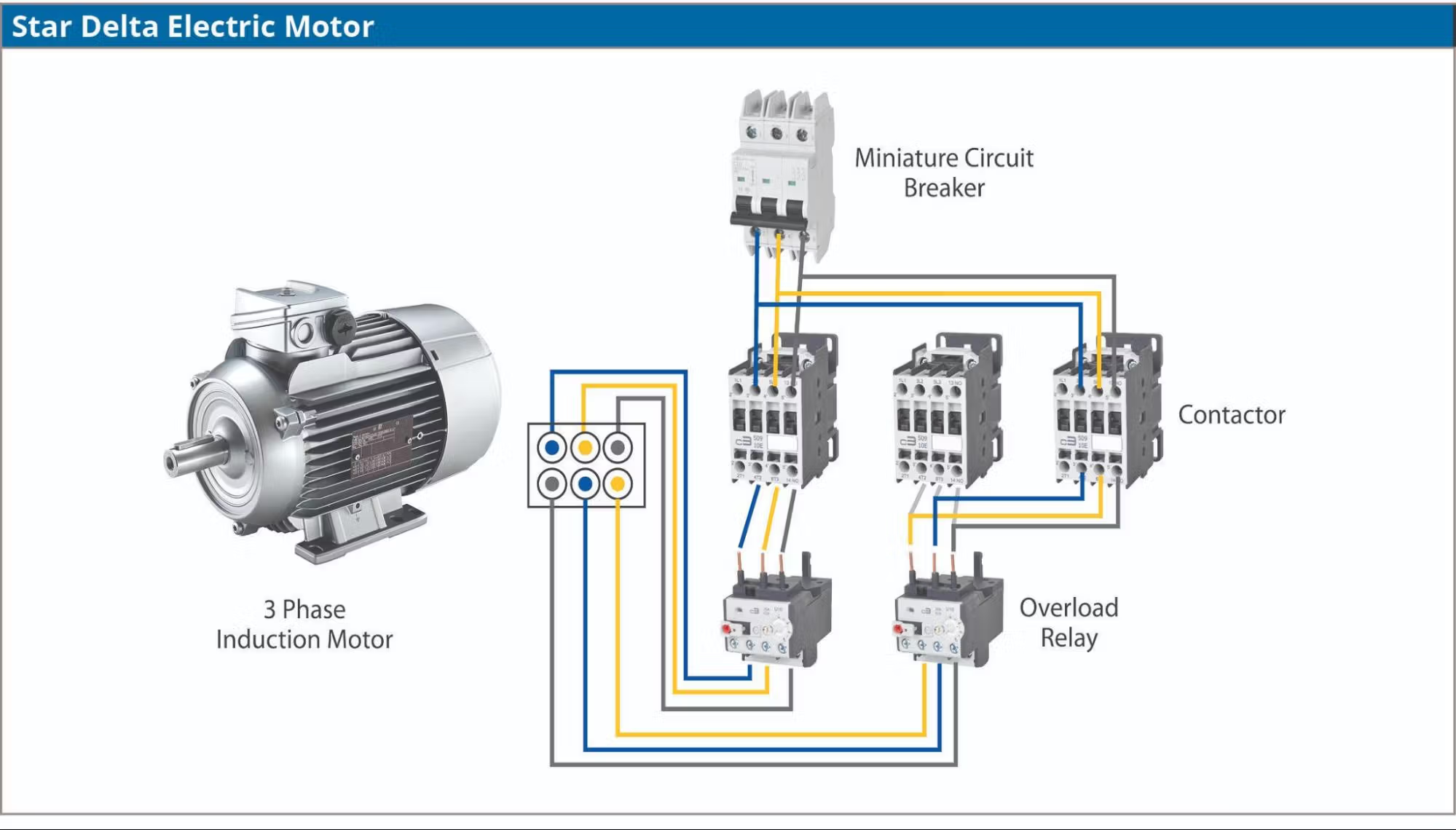
Summary
A contactor is a special type of relay used for switching an electrical circuit on or off. They are most commonly used with electric motors and lighting applications. The use of a contactor provides a level of isolation away from the high electric currents associated with those applications, protecting workers and equipment. IEC Contactors are smaller and are offered in a wide variety of sizes, whereas NEMA contactors are larger and designed with safety factors that go beyond design ratings by up to as much as 25%. IEC is a Global standard. NEMA contactors are primarily used in North America however, more companies are adopting IEC contactors, c3controls specializes in IEC.
Disclaimer:
The content provided in this white paper is intended solely for general information purposes and is provided with the understanding that the authors and publishers are not herein engaged in rendering engineering or other professional advice or services. The practice of engineering is driven by site-specific circumstances unique to each project. Consequently, any use of this information should be done only in consultation with a qualified and licensed professional who can take into account all relevant factors and desired outcomes.
The information in this white paper was posted with reasonable care and attention. However, it is possible that some information in these white papers is incomplete, incorrect, or inapplicable to particular circumstances or conditions. We do not accept liability for direct or indirect losses resulting from using, relying or acting upon information in this white paper.
ISO 9001:2015
Certified
17+ Million Product
Configurations
Lifetime
Warranty
Guaranteed
Same-Day Shipping
Advantage Pricing
Save Up To 40%
c3controls Headquarters, USA
664 State Avenue
Beaver, PA 15009
